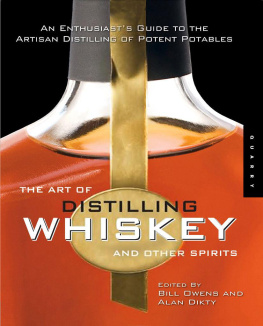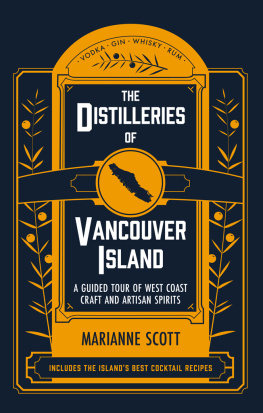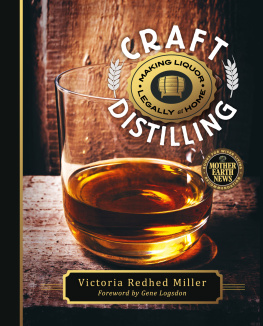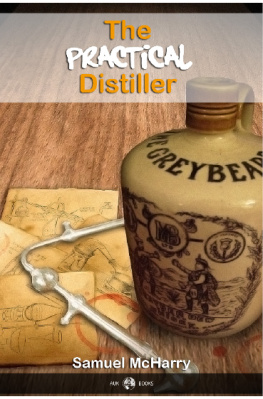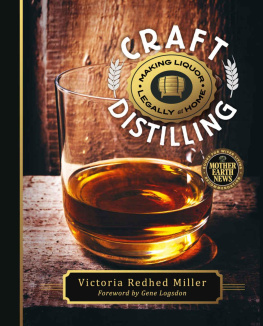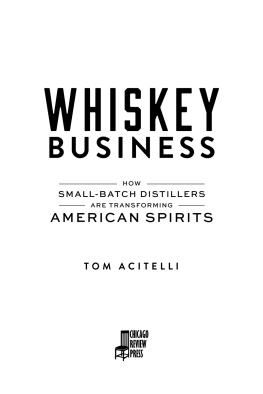THE ART OF DISTILLING
WHISKEY
AND OTHER SPIRITS
AN ENTHUSIASTS GUIDE
TO THE ARTISAN DISTILLING
OF POTENT POTABLES
EDITED BY BILL OWENS
AND ALAN DIKTY
FOREWORD BY FRITZ MAYTAG

DEDICATION
In fond memory of our friend Michael Jackson, who is, we have no doubt, now enjoying his well-deserved angels share of the worlds barrels of maturing whiskey

CONTENTS





FOREWORD
THE SECOND Whiskey Rebellion is happening in the United States, and it is already spreading around the world. In this marvelous book, Bill Owens, Alan Dikty, and their contributorslike intrepid war correspondentstake you to the front lines. You will find here an up-to-the-minute report on the excitement, creativity, and brash enthusiasm of the United States craft distillers.

Detail of the fermenting process of making bourbon, Woodford Reserve Distillery.
I have known Bill Owens since his early involvement in the U.S.s microbrewing renaissance: He was one of the movements most fervent innovators. His own achievements are many, and his enthusiasm for the whole wild explosion of brewing creativity is evidenced in his obvious enjoyment of the successes of his brewing colleagues.
The craft-brewing renaissance, of course, began in the 1960s. By the early 90s, it was inevitable that it would evolve into a craft-distilling renaissance. And so Bill and his cohorts are at it again, now celebrating a small-distillery revolution and the variety and creativity that is springing up everywhere. Yes, we now have craft whiskey distillers, experimenting with all facets of grain distilling. And, as with the brewing revolution, the consumer reaps the rewards. We are entering a golden age for the spirits lover, and The Art of Distilling Whiskey and Other Spirits: An Enthusiasts Guide to the Artisan Distilling of Potent Potables is an indispensable guidebook to its beginnings.

Charring oak barrels at Bluegrass Cooperage.
Where did the craft-distilling phenomenon originate? You could say that it came down from the mountains, where pot-distilled whiskeys made by handin secret foldshave never entirely disappeared. Or you could say that it came up from the vineyards and orchards, where for many years there has been a tiny craft-distilling segment of superb, hand-crafted fruit brandies and eaux-de-vie. Just know that a second Whiskey Rebellion is upon us and that it is happening right now in a little building near you. And if you have picked up this book already knowing about the great food awakening and hoping for a guide to distilling, you have found it!
What particularly fascinates me about the distillation of alcohol is the enduring mystery surrounding its origins. Distillation itself is a physical art with a longand colorfulhistory. And the distilling of all sorts of materials for myriad purposes is an ancient process. But when did the production of distilled spirits as a beverage begin? You are welcome to your opinion, and good luck finding anyone to agree with you! No matter what you think, I encourage you to savor the eternal enigma that is embodied in a distilled spirit. It is a form of magic to take fruit or grain, ferment it, put it in a pot, heat it and make it disappear entirely, and then watch it reappear, drop by drop, as a clear, volatile, almost ethereal liquid. And it is a dangerous liquiddo not kid yourself. It can catch fire, it can explode, and abusing it can ruin lives. It is powerful, mysterious stuff, surely one reason that it captures the imagination of the producers and consumers swirling and swilling around the current awakening.
So drink deep of Bill and Alans guide, get on the road with them, go exploring and learning, and enjoy being an early participant in the movement. And take my word for it, as a distiller of whiskey since the second Whiskey Rebel-lions first shot: Heads we win, tails we win!
Fritz Maytag
Anchor Distilling
San Francisco
April 2009
INTRODUCTION

AS A YOUNG MAN in the 1970s, I had long hair, a Volkswagen Beetle, a hip wife, and a career as a newspaper photographer. I also published four photography monographs, including the classic SUBURBIA (still in print), and I received a Guggenheim Fellowship in photography and three National Endowment for the Arts grants. My dream was to work for LIFE magazine or National Geographic, and I ended up stringing for the Associated Press and covered the Hells Angels beating people with pool cues at Altamont. While all this was happening, I was homebrewing in the garage.
By the 1980s, when I reached middle age, I had a flattop, sold the VW and cameras, and lost a wonderful wife. In 1982, I opened the first brewpub in the United States: Buffalo Bills Brewery in Hayward, California. The beer was good. My pumpkin ale is still being brewed by many breweries. My public image was colorful, and the news media loved me. I started believing my own press clips. I opened two more brew-pubs and launched a public stock offering to fund the building of a large-scale production brewery. It all seemed like a good idea at the time. It was, after all, Morning in America, Reagan was in the White House, and the operative phrase for the times was Greed is good.
I wanted success, money. I had three brewpubs. I grossed a million dollars that year, but I had to pay sixty employees and ended up with no profit. Things dont always work out as you dream. The stock offering never got off the ground, and one by one, the brewpubs were sold off, with Buffalo Bills being the last to go. But Ill always have Alimony Ale (The bitterest beer in America!).
By the 1990s, I had gray hair and a new wife, and I was publishing two magazines: American Brewer and BEER: The Magazine. Once again my timing was good, and the American Brewer rode the first great wave of craft brewing. Things were looking great, but financially, the two magazines turned out to be not such a great idea. I soon stopped publishing
Next page
